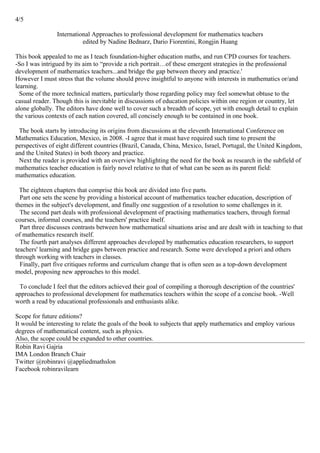Robin ravi gajria ima mathematics today review 2 international approaches professional development mathematics teachers
- 1. 4/5 International Approaches to professional development for mathematics teachers edited by Nadine Bednarz, Dario Fiorentini, Rongjin Huang This book appealed to me as I teach foundation-higher education maths, and run CPD courses for teachers. -So I was intrigued by its aim to “provide a rich portrait…of these emergent strategies in the professional development of mathematics teachers...and bridge the gap between theory and practice.' However I must stress that the volume should prove insightful to anyone with interests in mathematics or/and learning. Some of the more technical matters, particularly those regarding policy may feel somewhat obtuse to the casual reader. Though this is inevitable in discussions of education policies within one region or country, let alone globally. The editors have done well to cover such a breadth of scope, yet with enough detail to explain the various contexts of each nation covered, all concisely enough to be contained in one book. The book starts by introducing its origins from discussions at the eleventh International Conference on Mathematics Education, Mexico, in 2008. -I agree that it must have required such time to present the perspectives of eight different countries (Brazil, Canada, China, Mexico, Israel, Portugal, the United Kingdom, and the United States) in both theory and practice. Next the reader is provided with an overview highlighting the need for the book as research in the subfield of mathematics teacher education is fairly novel relative to that of what can be seen as its parent field: mathematics education. The eighteen chapters that comprise this book are divided into five parts. Part one sets the scene by providing a historical account of mathematics teacher education, description of themes in the subject's development, and finally one suggestion of a resolution to some challenges in it. The second part deals with professional development of practising mathematics teachers, through formal courses, informal courses, and the teachers' practice itself. Part three discusses contrasts between how mathematical situations arise and are dealt with in teaching to that of mathematics research itself. The fourth part analyses different approaches developed by mathematics education researchers, to support teachers' learning and bridge gaps between practice and research. Some were developed a priori and others through working with teachers in classes. Finally, part five critiques reforms and curriculum change that is often seen as a top-down development model, proposing new approaches to this model. To conclude I feel that the editors achieved their goal of compiling a thorough description of the countries' approaches to professional development for mathematics teachers within the scope of a concise book. -Well worth a read by educational professionals and enthusiasts alike. Scope for future editions? It would be interesting to relate the goals of the book to subjects that apply mathematics and employ various degrees of mathematical content, such as physics. Also, the scope could be expanded to other countries. Robin Ravi Gajria IMA London Branch Chair Twitter @robinravi @appliedmathslon Facebook robinravilearn

